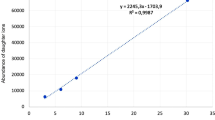Abstract
Maize (Zea mays) cell cultures were used for the production of zearalenone-4-β-D-glucopyranoside as standard compound. Wheat samples were extracted with acetonitrile: water, applied to a florisil column and eluted with methanol:ethyl acetate. For determination and quantification of zearalenone-4-β-D-glucopyranoside and zearalenone a LC-MS method was developed. A concentration of 10 μg/kg zearalenone-4-β-D-glucopyranoside and zearalenone was detectable. The recovery rates were calculated to be 69% and 89% at a concentration level of 100 μg/kg for zearalenone-4-β-D-glucopyranoside and zearalenone, respectively.
24 Bavarian wheat samples from harvest 1999 were analyzed. Zearalenone was present in 22 out of 24 field samples, the levels ranged from 11–860 μg/kg. Zearalenone-4-β-D-glucopyranoside was found in 10 out of the zearalenone positive samples (42%) at levels ranging from 17 to 104 μg/kg. The amounts of zearalenone-4-β-D-glucopyranoside were correlated to those of zearalenone (r2=0,86; b=0,10).
Similar content being viewed by others
Literatur
Bauer J, Heinritzi K, Gareis M, Gedek B (1987) Veränderungen am Genitaltrakt des weiblichen Schweines nach Verfütterung praxisrelevanter Zearalenonmengen. Tierärztl. Prax. 15: 33–36.
Chakrabarti D, Ghosal S (1986) Occurrence of free and conjugated 12, 13 epoxytrichothecenes and zearalenone in banana fruits infected with Fusarium moniliforme. Appl. Environ. Microbiol. 51: 217–219.
El-Sharkawy S, Abul-Haij Y (1987) Microbial transformation of zearalenone, I. Formation of zearalenone-glycoside. J. Nat. Prod. 50: 520–521.
Engelhardt G, Ruhland M, Wallnöfer PR (1999) Metabolism of mycotoxins in plants. Adv. Food Sci. 21: 71–78.
Etienne M, Jemmali M (1982) Effects of zearalenone (F2) on estrous activity and reproduction in gilts. J. Anim. Sci. 55: 1–10.
Gareis M, Bauer J, Thiem J, Plank G, Grabley S, Gedek B (1990) Cleavage of zearalenone-glycoside, a “masked” mycotoxin, during digestion in swine. J. Vet. Med. B. 37: 236–240.
Kamimura H (1986) Conversion of zearalenone to zearalenone-glycoside by Rhizopus sp. Appl. Environ. Microbiol. 52: 515–519.
Kollarczik BM (1990) Transformation von Mykotoxinen durch die Darmflora des Schweines. Diss. vet. med. München.
Author information
Authors and Affiliations
Rights and permissions
About this article
Cite this article
Schneweis, I., Meyer, K., Engelhardt, G. et al. Nachweis von Zearalenon-4-β-D-Glucopyranosid in Weizen. Mycotox Res 17 (Suppl 1), 87–91 (2001). https://doi.org/10.1007/BF03036719
Published:
Issue Date:
DOI: https://doi.org/10.1007/BF03036719




